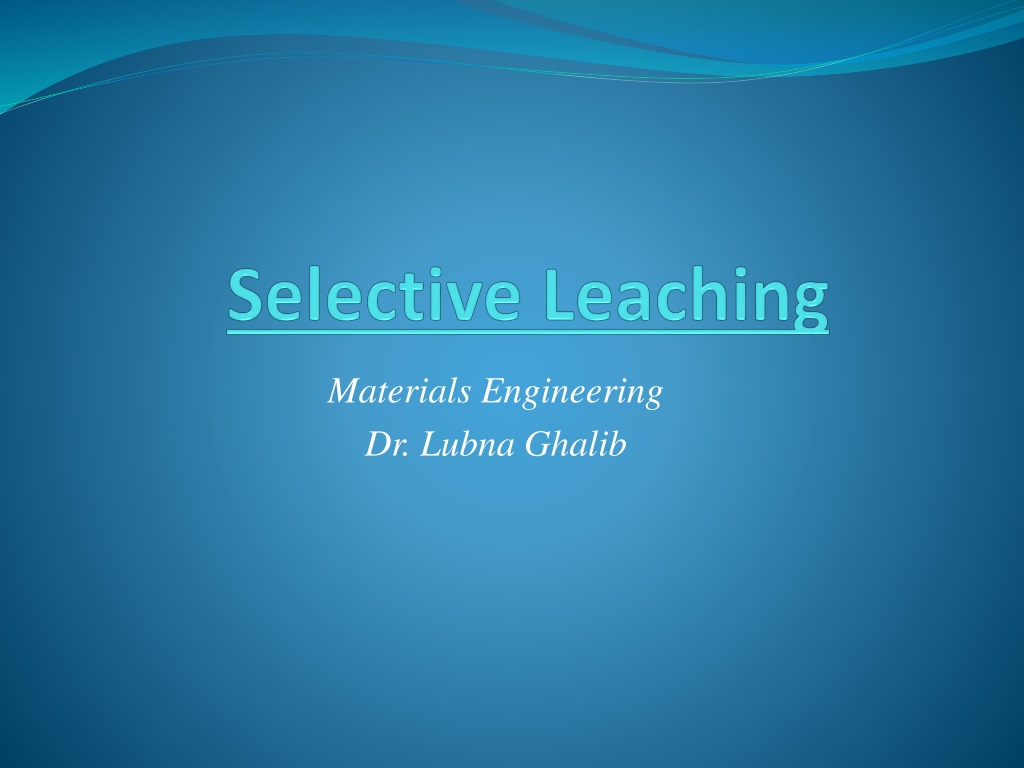Understanding Selective Leaching in Materials Engineering
Selective leaching, also known as de-alloying, is the process of selectively removing one element from an alloy through corrosion. Dezincification in brass is a common example of this phenomenon, where zinc is preferentially attacked, leaving behind a weakened copper structure. It can occur in different forms, such as uniform or localized types, based on the corrosive environment. Understanding the mechanisms and types of selective leaching is essential in materials engineering to prevent structural weakening in alloys.
Download Presentation

Please find below an Image/Link to download the presentation.
The content on the website is provided AS IS for your information and personal use only. It may not be sold, licensed, or shared on other websites without obtaining consent from the author. Download presentation by click this link. If you encounter any issues during the download, it is possible that the publisher has removed the file from their server.
E N D
Presentation Transcript
Materials Engineering Dr. Lubna Ghalib
Selective Leaching: Selective leaching is also called de-alloying, parting, and selective corrosion. De-alloying or selective leaching refers to the selective removal of one element from an alloy by corrosion processes. Corrosion in which one constituent of an alloy is preferentially removed, leaving behind an altered (weakened) residual structure, can occur in several systems.
Selective Leaching: A common example is the dezincification of brass, whereby a weakened, porous copper structure is produced, without modification of overall part dimensions.
Selective Leaching: Dezincification: It is a form of corrosion in which zinc is selectively attacked in zinc- containing alloys, like brasses. Dezincification is a form of de-alloying. As the phenomenon was first observed in brass in which zinc separated by dissolution from copper occurs in brass alloys that contain more than 15% zinc. Zinc within lattice. Zinc atoms dissolve into electrolyte in solid copper solution crystal
Selective Leaching: Dezincification types: Two forms of dezincification. Dezincified areas weakened or in some cases perforated Overall dimensions of the material do not change.
Selective Leaching: (1) Uniform type, like the potable water inside. In the uniform the active area is leached out over a broad area of the surface and it is not localized to certain point of the surface. Bulk electrolyte sufficiently corrosive to promote de-alloying. Uniform Layer dezincification in brass heat-exchanger tube. Usually found in high brasses (high [Zn]), acid environments.
Selective Leaching: (2) Plug or localized type, like boiler water inside, combustiongasesoutside. The plug type of attack is localized, at a certain point on the surface and surrounding area remains unaffected. Caused by local increases in electrolyte corrosivity Changes in electrolyte caused by Deposit on surface Local increase in temperature Brass (Cu-30% zinc) exposed to room temperature salt solution for 80 days Usually found in low brasses, alkaline, neutral or slightly acid environments.
Selective Leaching: Mechanism: Generally three mechanisms are proposed 1. Dissolution and re-deposition mechanism Entire alloy is dissolved first Active metal is leached away ( eg. Zn in Brass ) More noble metal is replated ( eg. Cu in Brass) 2. Selective dissolution One species is selectively dissolved from alloy leaving a porous residue of more noble metal behind 3. Combination of two methods The basis of dissolution and re-deposition mechanism.
Selective Leaching: 1) Zn atoms leave lattice sites . . . are leached into the environment selectively Zn Zn+2 + 2e 2H+ + 2e H2 CuCl2 Cu+2 +2Cl- Cu Cu+2 + 2e Cu+2 + Zn Cu + Zn+2 Step I Dissolution of Cu and Zn Step II Zinc stays in solution. Step III Copper plates back (2) Generally accepted . . . - brass dissolves; - Zn stays in solution; - Cu re-deposits. (I) dissolution (II) dissolution (III) plating ( eq. I & II ). ( eq. III ).
Selective Leaching: Zinc is quite reactive to corrosive environment while copper is more Nobel metal. 2. Zinc can corrode slowly in corrosive environment and leaching of zinc occurs in brass which makes porous structure of copper. This mechanism is called dezincification. 3. The analysis of dezincified area shows 90 to 95% copper with present as copper oxide. 4. When oxygen is present then it also enters into cathodic reaction and increase rate of attack. 5. The material remaining is a copper-rich sponge with poor mechanical properties, and a color changed from yellow to red. 6. Dezincification can be caused by water containing sulfur, carbon dioxide, and oxygen. Stagnant or low velocity waters tend to promote dezincification. 1.
Selective Leaching: Selective leaching of material depend on, Alloy composition Environment
Selective Leaching: Prevention:- 1. Reducing the aggressiveness of the environment (i.e. Oxygen removal) 2. Use less susceptible material: - 15% Zn (red brass) - Addition of 1%Sn in 70-30 brass which improve resistance towards dezincification. - Addition of As, Sb, P as inhibitor (70%Cu, 29% Zn, 1% Sn, 0.04% As) - Cupronickel (70-90%Cu, 30-10%Ni) is used in severely corrosive environments.
Selective Leaching: Alloy Environment Element removed Composition Many waters, especially under stagnant conditions Soils, many waters Hydrofluoric acid, acids containing chloride ions High-temperature steam and acidic species Hot brines or steam High heat flux and low water velocity (in refinery condenser tubes) Brasses Zinc (De-zincification) Gray iron Aluminum bronzes Fe (graphite corrosion) Aluminum (De- aluminification) Silicon bronzes Silicon Tin bronzes Sn (De-stannification Copper-nickels Ni (De-nickelification) Copper-gold single crystals Ferric chloride Cu
Selective Leaching: Alloy Environment Element removed Composition Cu in some acids, and Ni in others Monels Hydrofluoric and other acids Gold alloys with copper or silver High-nickel alloys Medium and high-carbon steels Iron-chromium alloys Nickel- molybdenum alloys Sulfide solutions, human saliva Copper, silver Molten salts Cu, Ag, Cr, Fe, Mo and T Oxidizing atmosphere, hydrogen at high temperatures C (De-carburization) High-temperature oxidizing atmospheres Cr, which forms a protective film Oxygen at high temperature Mo























